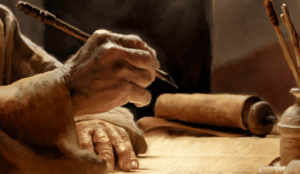“…a time is coming and has now come when the true worshipers will worship the Father in spirit and in truth, for the Father is seeking such as these to worship Him. God is Spirit, and His worshipers must worship Him in spirit and in truth.” Jn. 4.23-24
My dearest friend and father in the faith, Sergio Valori, used to emphasize the Biblical word perfection. People would often think the word perfection meant being flawless, pure or spotless; and thereby render it unattainable in this life. They would speculate that such perfection is achieved only by grace, freely bestowed upon one being in Christ. While it is true that on the one hand the believer is legally, or judicially, found righteous in Christ (Phil. 3.9), there is also a corresponding “practical” fruit of righteousness (Phil. 1.11) that must be considered—which is not automatic or a gift, but comes with the pursuit of patience and faithfulness.
Therefore, the Biblical word for perfection actually means “to become” mature or complete; and in some newer Bible translations the word is actually rendered mature. We now understand that perfection is really attainable because maturity is a particular stage of growth as one matures from a babe, to an adolescent to an adult, and even continuing on into adulthood. It is progressive, dynamic, involving and requiring positive changes. To mature physically is somewhat automatic; as trees grow to maturity so do our bodies. But proper maturity mentally, emotionally, and spiritually, is not automatic, much is required. I believe everyone realizes what it takes to mature thus, but not everyone is willing to put forth the effort. There is a whole range in maturity level between the sophisticated and the unpolished, the skilled and untrained, the scholarly and unlearned, the assured and insecure, the brave and coward, the spiritually minded and the fleshly minded, as well as extreme variations in morality of character.
So it is with worship. To bring to maturity worship is a lifetime of spiritual growth and development—from the most simplistic to the highest order of worship accompanying the angels of heaven; from the light-hearted to the most solemn; driven by thought and emotion or by faith; or from exquisite in style and technique to excellence in spiritual quality. There is nothing wrong with the simplistic worship of babes in Christ, unless one finds their camp in this level of devotion. Jesus said, “Let the little children come to Me, and do not hinder them! For the kingdom of heaven belongs to such as these.” Mt. 19.14
However, for a relationship to mature, little children must grow up. I once could only hold my baby daughter in my arms and try to soothe her, but as she grew to a child I attempted to play simple games with her and connect with her in a different way. My relationship with her then changed as she became a teenager as I attempt to instill to her moral principles and to broaden her understanding of life. Now, as a wife and mother of my three grandchildren there is yet and ever expanding relationship into areas never anticipated. My relationship with her matured over time. I would be saddened if she acted towards me today as a babe or child, for I now value and anticipate something much higher. I have found that over time there was a progression from me giving of myself 100%, to her giving of herself increasingly more and more over time. Now it seems like we try to out-give one another, not just materially but in caring for one another in many ways. However, if you can receive the spiritual implication, all that I have one day she will inherit…for I am always the father.
So, do you see that worship, our most fundamental interaction with our Father and Lord Jesus Christ, involves a relationship and communion in the Spirit, that grows and matures over time, never remaining static; and the focus of that relationship shifts with maturity from self and what is for me to Him, and the desires of His heart for me, and the fulfilling of His purposes in my life—Thy will be done. Jesus revealed the Father’s heart when He said to the Samaritan woman, “the true worshipers will worship the Father in spirit and in truth, for the Father is seeking such as these to worship Him.” Jn. 4.23 Our upward pursuit therefore is to draw near to God, in spirit and truth, and He will draw near to us. Jam. 4.8
A Pattern for Worship
There is no greater pattern for worship in the entire Bible than in the Old Covenant regarding the Law and the tabernacle and all the activities that surround it; such as the blood sacrifices, washings, various services involving the Lampstand, the Table of Showbread, the Incense Altar, and the utmost approach to the Ark of the Covenant located in the Most Holy Place, within the veil. With all its earthly significance, and especially to the Jew, it is not something to be duplicated or established as a mode of worship for today. Why? For two reasons—it is but an earthly pattern for worship and not the end product itself, and the fullness of time has come for worship in a new dimension in spirit and truth.
Pattern
“And they are to make a sanctuary for Me, so that I may dwell among them. You must make the tabernacle and design all its furnishings according to the pattern I will show you.” Ex. 25.8-9
The fact must be realized the Israelites were not a spiritual people. Yes, they acknowledged and worshiped the one and only true God, but everything that surrounds their lives, and their worship, was of the flesh. It was all outward, pertaining to the natural man: physical sacrifices of animals and grains; dress codes and the Law to live by; divine favor for long life, preservation from hunger and from their enemies; and an earthly kingdom. Yet in all of this there remained a promise, that of a coming Messiah. Something remained in their “religion” unfulfilled. Because this covenant with Israel was an earthly covenant the mode of worship could only be after a pattern of the real, spiritual tabernacle of heaven. This earthly tabernacle, and all its furnishing, services, and activities were copies of the true, but not spiritual reality itself. It involved the natural man who was being governed by his five senses, his sense of reasoning and understanding, and emotions. The inward man of the spirit was yet to come alive, waiting upon the Messiah, our Christ.
The fact remains, the tabernacle and the Law was temporary, a pattern or model for true worship, awaiting only for the fullness of time. It would then cease and vanish away as a mode of worship.
Fullness of Time
“But when the fullness of the time came, God sent forth His Son, born of a woman, born under the Law, so that He might redeem those who were under the Law, that we might receive the adoption as sons. Because you are sons, God has sent forth the Spirit of His Son into our hearts, crying, “Abba! Father!” Therefore you are no longer a slave, but a son; and if a son, then an heir through God.” Gal. 4.3-7
If the fact that the O.T. tabernacle was a pattern, or a copy for true worship, this second fact that all the religious practice that surrounded the first covenant, the Law, and all the religious activities that surrounded the tabernacle ended with the advent of the Messiah, Christ. In prophesy, God foretold of this, “When He said, ‘A new covenant,’ He has made the first obsolete. But whatever is becoming obsolete and growing old is ready to disappear.’” Heb. 8.13 In short, all these religious practices of worship under the Old Covenant terminated with Christ, who was to bring to reality worship in spirit and truth. (Jn. 4.23-24) He did this by entering the true, spiritual tabernacle, with His own blood, sprinkling it on the Mercy Seat in heaven, atoning forever the sins of man, and opening the way for a higher spiritual fellowship. The following three scriptures are of utmost importance and are the foundation for understanding that “the way” has been opened, the veil torn, for true worship in spirit and truth:
“Now the main point in what has been said is this: we have such a high priest, who has taken His seat at the right hand of the throne of the Majesty in the heavens, a minister in the sanctuary and in the true tabernacle, which the Lord pitched, not man.” Heb. 8.1-2
“But when Christ appeared as a high priest of the good things to come, He entered through the greater and more perfect tabernacle, not made with hands, that is to say, not of this creation; and not through the blood of goats and calves, but through His own blood, He entered the holy place once for all, having obtained eternal redemption.” Heb. 9.11-12
“Therefore, brethren, since we have confidence to enter the holy place by the blood of Jesus, by a new and living way which He inaugurated for us through the veil, that is, His flesh, and since we have a great priest over the house of God, let us draw near with a sincere heart in full assurance of faith, having our hearts sprinkled clean from an evil conscience and our bodies washed with pure water.” Heb. 10.19-22
Now, I beg you, re-read these passages of scripture letting your mind-set be challenged and changed, from the earthly to the heavenly, from the fleshly to the spiritual. With this understanding, let us proceed to the interpretation of the pattern of the tabernacle and worship in spirit and truth.
Interpretation of the Tabernacle Pattern
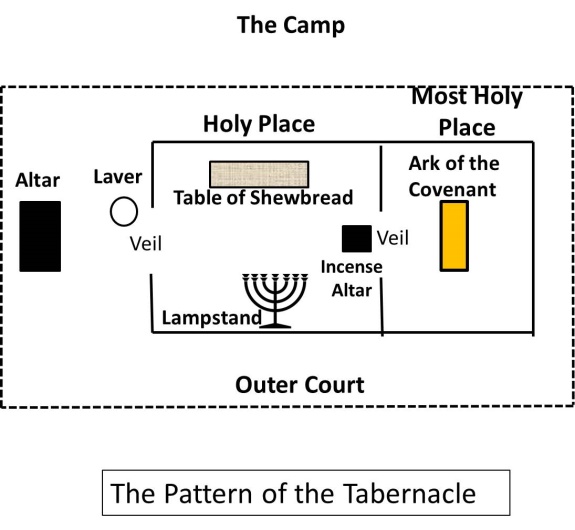
We will now begin to unveil the pattern of the tabernacle and how it foreshadows the way of true worship –in spirit and truth. These writings will be altogether different than what most believers have experienced in their past; for just as the O.T. tabernacle of worship is of the natural and not spiritual, so much of today’s worship in the church also involves much of the natural: the intellect, physical senses, reasonings, emotions, and outward demonstrations. We must now learn to walk and worship in Spirit. Much of this is new, and even as a baby must first learn to crawl, then to waddle in its first steps, then to walk upright, and finally learn to run, so must every believer learn grow in worship in the spirit. We must begin with proper understanding, Biblical evidence, faith, and pursuit to His highest.
To begin, note in The Pattern of the Tabernacle illustration the four major positions one may find themselves in in relations to the tabernacle’s holiest place of all, the presence of God over the Ark of the Covenant: the Camp, the Outer Court, the Holy Place, and the Most Holy Place.
The Camp
The Camp area is where the Israelites lived and dwelt, worked and played. The twelve tribes of Israel camped on all four sides of the tabernacle. Though in view of the tabernacle, the camp was isolated from the tabernacle. Even though one may see this place of worship, the focus was more on self and survival and daily activities than on worship itself. I am reminded of the many sections of towns and cities that have developed around a particular church; the church being central to, but not dominant of life’s activities.
Intermixed in the Camp were places and activities for dwelling, business, school, play, military, and so on. Also, intermingled within the Camp were foreigners with their families serving and interacting with the Israelites. And, around all of this, were the nations of the world, some friendly, some hostile.
Worship in the Camp? Any “religious” activity in the Camp was outside the tabernacle, and therefore falls short of true worship. It would be understandable that prayers were said, the Torah read, and hymns were sung; none of which constituted the weightier worship associated with the sacrifices and rituals of the tabernacle. Such religious devotions in the Camp are akin to similar observances in the church today. These involve prayers of intercession and supplication, songs of testimony of the Gospel and salvation, readings of scripture, Bible studies and Sunday schools, church rituals, and various church services. These all may have a place in the church, but do not constitute worship.
An example of some songs and prayers associated with the Camp are:
PETRA
Reciting the Lord’s Prayer
Come and let us go up to the mountain of the Lord….
I have been washed in the blood of the Lamb…
Proceeding on to the Tabernacle: A Proper Mindset for Worship
Before entering into a detailed discussion of worship as it relates to the pattern of the tabernacle, it is necessary to lay a few necessary foundational thoughts. The following four concepts are very critical:
- Focusing on the spoken word in song and statement.
- Speaking directly to God, and not to one another, or to God in the third person (He, Him.)
- Recognizing that the various parts of the tabernacle have spiritual significance.
- Knowing the distinction between worship and speaking (or telling), and prayer.
1) Focusing on the Spoken Words. Oftentimes words are sung or spoken as praises rotely, or machine-like out of memory or by habit without reflecting on the words or phrases. Sometimes songs are sung so often that the mind tends to drift upon other thoughts. One must listen to, and entertain in the mind, the words spoken. I don’t like to use the expression forced meditation because of a possible misinterpretation, but I think it adequately enforces the point being made. One needs to listen to and meditate upon each and every word and phrase, and sentence voiced, whether spoken or sung. Lock in on exactly what you are you proclaiming. Let it become as one thought. “For out of the abundance of the heart the mouth speaks,” Mt. 12.34 Are the words truly reflective of the heart or are we just voicing words and songs while our minds are actually entertaining other matters?
Examine the words spoken. Are they actually words of worship or are they words of testimony, or of petition, or simply confessing the promises of God? Or, are they speaking of the weightier matters of exalting God Himself and the Lamb who sits upon the throne, with hearts full of thanksgiving and adoration, with spirits broken and humble before Him?
2) To Whom are you Addressing? Are you the object of the words spoken, such as “I am”, “I have”… ? Or, maybe others are the object of worship, “he” of “she”… Is the Lord even mentioned in the words? We must also be remembered, words may be directed earthward for self and individuals or heavenward to our Father and Lord Jesus Christ—one can say “bless me” or “bless another” or he can say, “blessed be the God and Father of our Lord Jesus Christ.” And if God is mentioned, are the words indirectly about “Him” or “He”, or are they directly speaking to God as “You”, as if you are standing before the Living God, which in spiritual reality you are. Are we really in an attitude of worship or are we merely singing songs of entertainment and boosting one’s emotions and self-assurance, and/or doing our religious duty? The alternative is the soberly and reverently drawing near to God the Father and Lord Jesus Christ in humble adoration

3) The Spiritual Counterpart of the Tabernacle. Please note once again the illustration the three major divisions of the Tabernacle: the Outer Court, the Holy Place, and the Most Holy Place. The first two symbolically speak of Christ, and the latter speaks of God the Father. The approach to worship must begin in the Outer Court where:
- the Altar of Burnt Offering prefigures the cross of Christ (Col. 1.20)
- the Laver speaks of His washing of water by the Word (Eph. 5.26)
- the veil(s) represent the body of Christ which veiled His deity in flesh, and was rent at the cross. (Heb. 10.20)
All worship must have its origin with the blood offering for sin, the atonement, and the resulting sanctification and justification by grace.
The elements of the Holy Place speak also of Christ, but now in a different relationship to the believer. Here it is not so much as what He has done for man in His atoning sacrifice, but what He is presently to man as:
- the Table of Shewbread speaks of Christ as the Bread of Life that sustains and nourishes. (Jn. 6.48, 51, 54)
- the Lampstand that represents Christ as the Light of the World. (Jn. 1.4,9; 1 Pet. 2.9)
- the Incense Altar prefigures Christ who now is our intercessor for us. (Rom. 8.34; Heb. 7.25)
The single furnishing of the Most Holy Place, the Ark of the Covenant, is symbolic of the highest, most gloriest sanctuary of God our Father, in the heavens. God would manifest Himself between the two Cherubim that rested on the mercy seat atop the Ark:
- the Ark of the Covenant which represents the Throne of God in Heaven. (Heb. 12.22-24)
This plan of worship clearly shows the singleness of Christ as Savior and the only Way to the Father:
 “Jesus answered, ‘I am the way, the truth, and the life. No one comes to the Father except through Me.’” Jn. 14.6
“Jesus answered, ‘I am the way, the truth, and the life. No one comes to the Father except through Me.’” Jn. 14.6
4. The Distinction between Worship in Song and Speaking (Telling), and Prayer. There is a time for speaking and for song in worship and a time for prayer outside of worship; but not an intermix at the same time. The focus is altogether different. The psalmist writes and truly defines worship:
“Sing to Him, sing praises to Him; Speak of all His wonders.” Ps. 105.2
Worship constitutes singing praises to God, and speaking forth His wonders. Take this no further, allow no exceptions to enter. Worship is from the heart of man directly to God. It is standing before Him, by faith, and telling forth these wonderful words of praise and adoration. Worship does not ask for or petition anything. Everything expressed is Godward. God is worshiped simply because He is God!
Times of prayer are very legitimate and encouraged. We certainly have enough Biblical examples of prayer by our Lord and by the disciples. But prayer represents a separate and distinct time of communion with God. Prayer is asking, petitioning from God for our wishes; this can also be done in word and in song. Scripture is clear and precise, “Therefore we should come with boldness to the throne of grace, so that we may receive mercy and may find grace for help in time of need. Heb. 4.16
In our little church fellowship, we often conclude our time of worship with an extended time of prayer. This is based upon a parable of Christ:
“Which of you whose servant comes in from plowing or shepherding in the field will say to him, ‘Come at once and sit down to eat’? Instead, won’t he tell him, ‘Prepare my meal and dress yourself to serve me while I eat and drink; and afterward you may eat and drink’? Does he thank the servant because he did what he was told? So you also, when you have done everything commanded of you, should say, ‘We are unworthy servants; we have only done our duty.’” Lk. 17.7-10
Minister to the Lord God first, and only afterwards come to Him in prayer and intercession. One may become surprised at how much of those things that beset us absolve in in the presence of worship. It is simply the way of the Spirit.
Worship in the Outer Court
It is in the Outer Court that one first realizes they have entered within the gate of the tabernacle, though not into the tabernacle proper itself. The focus is altogether different than in the Camp. Attention is drawn to the Altar of Burnt Offering, and to the Laver of water. These speak of the proper cleansing of the priests before any progression can be made into the tabernacle. No advance can made into the tabernacle without first fully performing all the duties of ritualistic cleansing. Any attempt to do so would be unacceptable by God and considered an abomination worthy of death.
Under the Old Covenant all was done in the physical as ritualistic and legal with the blood of bulls and goats, the sprinkling of ashes, words of absolution spoken, and cleansing in water from head to toe. But the realm of the physical is no more for the believer. Now the walk is by faith in the intangible and invisible. It is being fully convinced that Christ resurrected from the dead and took His own blood shed at the cross into heaven itself, and sprinkled it on the mercy seat at the throne of God. (Heb. 9.11-15) It is now time to lay aside the rituals and rites of religion for an altogether different way:
”Therefore, brethren, since we have confidence to enter the holy place by the blood of Jesus, by a new and living way which He inaugurated for us through the veil, that is, His flesh, and since we have a great priest over the house of God, let us draw near…” Heb. 10:19-22
The Veil and the Eternal Nature of Things
These are thoughts too lofty for the natural mind. It is as Jesus told Nicodemus that unless he was born again (Of His Spirit) that he could not even see, less enter into, the Kingdom of God—the Kingdom of God not being some mystical realm, but an inward awakening to a relationship with God in the Spirit. The things of the Spirit are incomprehensible to the natural mind who wants only to see in the natural: altars, bodies of sacrifices, and fonts for bathing. Many will have difficulty understanding this, they prefer to dwell upon the historical Christ, the one veiled in the flesh (body) of Jesus; and of a past work, never entertaining the present and future reality of the eternal nature of the cross.
Being hewn out of a tree, the cross upon which Jesus was crucified was most real, and tangible. It served the purpose for His crucifixion in the flesh. This flesh was a veil to Jesus, for what one could not see through this veil was His eternal nature. “For in Him all the fullness of Deity dwells in bodily form.” Col. 2.9 He is the Christ, the Son of the Living God. He always was and always will be eternally divine. The eye of man could not see this nor could his hand touch it. His true nature was hidden beneath the veil, of His flesh. Do you see this? Recalling a few stanza from an old carol, Hark the Harald Angles Sing:
Veiled in flesh, the Godhead see;
Hail, th’incarnate Deity:
Pleased, as man, with men to dwell,
Jesus, our Emmanuel!
Isaiah the prophet wrote of Him, “He has no stately form or majesty that we should look upon Him, Nor appearance that we should be attracted to Him.” Is. 53.2 The flesh of Christ was but a veil to His glorious incarnate Deity. It is so important that we understand that the crucifixion, His blood shed and His body torn apart on the cross, unveiled the resurrected Christ, this mystery of God now revealed.
There is too an eternal nature veiled in the cross of Christ. This “old wooden cross” existed at a point in time for a purpose. Yet, veiled within that cross, is a mystery waiting to be revealed. For those who have an ear to hear to hear let him hear. There is an eternal nature to the cross that transcends time and space. This cross existed unseen at creation in the mind of God, hidden in His curse of Satan, “He shall bruise you on the head, And you shall bruise him on the heel.” Gn. 3.15, prefigured in copies and types in various altars down through the ages, and manifested one last time on a hill called Golgotha. What has been veiled in altars and crosses through the centuries is being unveiled as something eternal, operative today, this hour, and tomorrow.
“If we confess our sins, He is faithful and just to forgive us our sins and to cleanse us from all unrighteousness.” 1 Jn. 1.9 speaks of “today.” It is the continuing work of the cross to cleanse, redeem, sanctify and make righteous a people. Many seek for artifacts of the old, the original. “If only I had a splinter of that original cross, how meaningful that would be,” they dream. Fifty years after the crucifixion, the wooden cross now perhaps used for firewood, a piece of furniture, or fence post never to be seen in the context of the cross of Christ again, Paul writes, “I have been crucified with Christ; and it is no longer I who live, but Christ lives in me; and the life which I now live in the flesh I live by faith in the Son of God, who loved me and gave Himself up for me..” Gal. 2.20 O’ do you see the eternal nature of the cross? A half–of-century later the eternal cross is still operative, being visited again and again by Paul and other believers, if by any means there be an unveiling of that divine nature from within.
It is finished! The altars are no more, the veil has been removed. It is a New Covenant, a new way in Spirit. It is the way of faith, of seeing the invisible nature of the Kingdom, beginning with the resurrected Christ, and now the eternal cross. Relics of the past and artifacts only lock us into the unprofitable realm of nature, keeping all things within the veil, keeping in secret the mysteries of God.
And so, worship in the Outer Court begins the progression towards the Holy Place in full view of, and embracing the eternal Christ, and the eternal cross, upon which He was crucified. And if you can receive it, it is the same eternal cross of co-crucifixion we died upon that this inward life of Christ might be unveiled. He is called, The Lamb of God. Enter into worship not in time or place, or formality, or befitting dress, but in faith, with adoration and thanksgiving to Savior Jesus Christ, Sing now and tell of His wondrous works!
Lamb of God, Jesus Christ, I worship you….
Worthy, the Lamb who was slain…
PETRA
So it is here, in Outer Court worship, that we acknowledge Christ as the Lamb of God, and declare Him SAVIOUR. He is our redeemer, our deliverer. “For He rescued us from the domain of darkness, and transferred us to the kingdom of His beloved Son.” Col. 1.13 Now, for those who would believe, this “transferred into the Kingdom” is through the first veil into the Holy Place, the place of Kingdom relationship with God the Father and the Son.
Worship in the Most Holy Place
I believe the Holy Place, with all its furnishings of the lampstand, Table of Shewbread, and incense altar brings to life and spiritual reality Jesus’ words,
“I am the vine, you are the branches; he who abides in Me and I in him, he bears much fruit, for apart from Me you can do nothing.” Jn. 15.5
O’ the soberness of the unveiling of this mystery! It has nothing to do with religion, articles of faith, rituals, oaths, or good intensions. It speaks most highly of a spiritual relationship with Christ in which He becomes our:
“Bread of Life” that sustains and nourishes us. (Jn. 6.48, 51, 54) Not in any outward way that feeds our fleshly appetites, but inwardly, spiritually, feeding that “new man” created in Christ Jesus. They say in the natural, “You are what you eat.” This is more so in the spirit. We must feed upon Him in nearness of worship in songs of adoration and speaking of His marvelous deeds, His nature, and character. (Only time and space limits a fuller discourse.)
Table of Shewbread

“Light of the Word” (Jn. 1.4,9; 1 Pet. 2.9) . Do you know that inside the Holy Place there was no natural light? The only illumination was from the olive oil that burns in the lamps of the Lampstand. It could not come from natural sunlight. The light that comes into the believer cannot come from any natural source such as prominent scholars, religious men and women, and ancient writings. There are many great unveilings of truth that may come into our lives that completely alters our lives, but none so great of the following two examples:
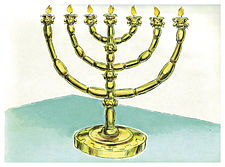
Lampstand
- “This is eternal life, that they may know You, the only true God, and Jesus Christ whom You have sent.” Jn. 17.3 To know is to become illuminated, not just in understanding, but understanding is preceded by experience. Here, Jesus points out the fact that “zoe”, the life of God, is not attainable from within man, his own wisdom, skills, personal sacrifices, cunningness, or diligence; but can only come by His unveiling in our hearts. Simply put, life, which may begin now and extend into eternity, is the experiential relationship with God the Father and Lord Jesus Christ. He is the only source of this light and life. Drawing near to Him in such a manner is dwelling in this light.
- “…I might fully carry out the preaching of the word of God, that is, the mystery which has been hidden from the past ages and generations, but has now been manifested to His saints, to whom God willed to make known what is the riches of the glory of this mystery among the Gentiles, which is Christ in you, the hope of glory.” Col. 1.25-27 The unveiling of the Word of God, the revealing of mysteries hidden since the foundation of the earth, are revealed here. How awesome the truth… Christ in you, the hope of glory. It is overwhelming to contemplate, and can only really be received by faith, making the confession, “…the Spirit of Him who raised Jesus from the dead dwells in me, He who raised Christ Jesus from the dead will also give life to my mortal body through His Spirit who dwells in me.” Rm. 8.11
Incense Altar The last article of furniture in the Holy Place to point to Christ is this altar of incense. It was placed before the veil that separated the Holy Place from the Holy of Holies. On the other side of the veil was the Ark of the Covenant, where was the presence of God. (Ex. 25.22) In scripture the burning of incense is often associated with prayer. David prayed, “May my prayer be set before you like incense.” Ps. 141:2
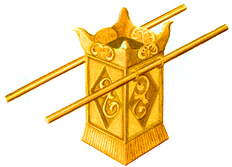
Golden Altar of Incense
But now, however, we do not have prayers from man and an earthly priesthood offered on our behalf before God, but we have Christ Himself offering such prayers.
“Who is there to condemn us? For Christ Jesus, who died, and more than that was raised to life, is at the right hand of God—and He is interceding for us.” Rm. 8.34
So, here it is, the very last stop before passing through the veil into our Father’s presence, Christ is proclaiming us cleansed and sanctified; not upon our merit but upon His redeeming blood.
O’ this is no little matter or a nice thought. This is spiritual reality and our preparation for worship in the realm of the Spirit. How our thoughts and hearts must be caught up with such surpassing riches and blessings in Christ. To be placed in such an exalted place. Must we not break forth in song, and to speak of all His wondrous deeds in thanksgiving and praise.
“But because Jesus lives forever, He has a permanent priesthood. Therefore He is able to save completely those who draw near to God through Him, since He always lives to intercede for them.” Heb. 7.24-25
To be saved completely is to be saved spirit (past in salvation), soul (presently ongoing), and body (future resurrection). To contemplate all of this as we draw close to God.
Communion. It has long been the habit of my little church fellowship to incorporate the practice of Holy Communion as we contemplate worship, in its progression from the Outer Court, through the veil into the Holy Place, to the veil before the Most Holy Place. For the simple act of the Lord’s Supper lends itself totally to all thoughts on the cross and of the Lamb of God, to feed upon Him as the Bread of Life, to dwell in revelation of God as the Light of the World, and to be presented by Him to our Father. To those who receive it, the elements of communion, are the body and blood of Christ, which are veiled in the tangible bread and wine. One is limited only by his or her faith
Worship songs of the holy place PETRA
Worship in the Most Holy Place
The sole piece of furniture in the Most Holy Place is the Ark of the Covenant described in Exodus 25. But most specifically God instructed Moses, “And I will meet with you there above the mercy seat, between the two cherubim that are over the Ark of the Testimony; I will commune with you about all that I command you regarding the Israelites.” Ex. 25.22 It should become quite clear that this place, and this Ark, is a shadow of the very Throne of God; now hidden beneath the veil of the visible and tangible. Books may well be written on the finest details surrounding the Ark of the Covenant and how each has a spiritual significance. But that is not the point here. May we only ask the question, “What does this all mean for worship in the Most Holy Place?
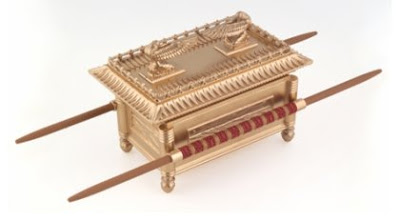
Ark of the Covenant
We can theorize and speculate the nature of this realm of the sanctuary of God, but to no avail. It is spoken of and describe in various ways by the prophets and in the Book of Revelation. But nothing seems to come close to its description in Hebrews:
“But you have come to Mount Zion and to the city of the living God, the heavenly Jerusalem, and to myriads of angels, to the general assembly and church of the firstborn who are enrolled in heaven, and to God, the Judge of all, and to the spirits of the righteous made perfect, and to Jesus, the mediator of a new covenant, and to the sprinkled blood, which speaks better than the blood of Abel.” Heb 12.22-24
“But you have come…! This is not some future speculation but a present reality. The sanctuary scene explodes innumerable company of angels not flittering around aimless but with purpose, of believers having passed from this life (perhaps only waiting for the resurrection of their bodies bringing to completion their salvation.) But the focus is upon is upon the throne where God, the Judge of all resides, who is our Father. We have come to worship Him, to honor and praise Him with all our hearts for being a loving God … But you, O Lord, are a God merciful and gracious, slow to anger and abounding in steadfast love and faithfulness. Ps. 86.15
And yet, there is One more present, to Jesus, the mediator of a new covenant. Look at Him closely. You have spiritual eyes to see. You know no other could be seated at the right hand of the Father. Look at His hands. Even in His resurrection of a new body He has retained the nail prints of the crucifixion, for He will ever and ever be The Lamb of God, our Savior.
Songs of worship PETRA
A Final Note
We have walked here, and dabbled in the realm of the spirit. Let us now carefully weigh out in our lives that of the flesh and that of the spirit. Worship is of the Spirit. What is of the flesh is temporary, fading away. What is of the Spirit is eternal. Consider now this Godly exhortation:
“And His voice shook the earth then, but now He has promised, saying, “YET ONCE MORE I WILL SHAKE NOT ONLY THE EARTH, BUT ALSO THE HEAVEN.” This expression, “Yet once more,” denotes the removing of those things which can be shaken, as of created things, so that those things which cannot be shaken may remain. Therefore, since we receive a kingdom which cannot be shaken, let us show gratitude, by which we may offer to God an acceptable service with reverence and awe; for our God is a consuming fire. Heb. 12.26-29
I stand to be shaken. My personal life, my relationship with others, and my relationship with God; in Godly worship and service. Shake violently, O Lord, so that what might remain, now and forever more, be acceptable.



